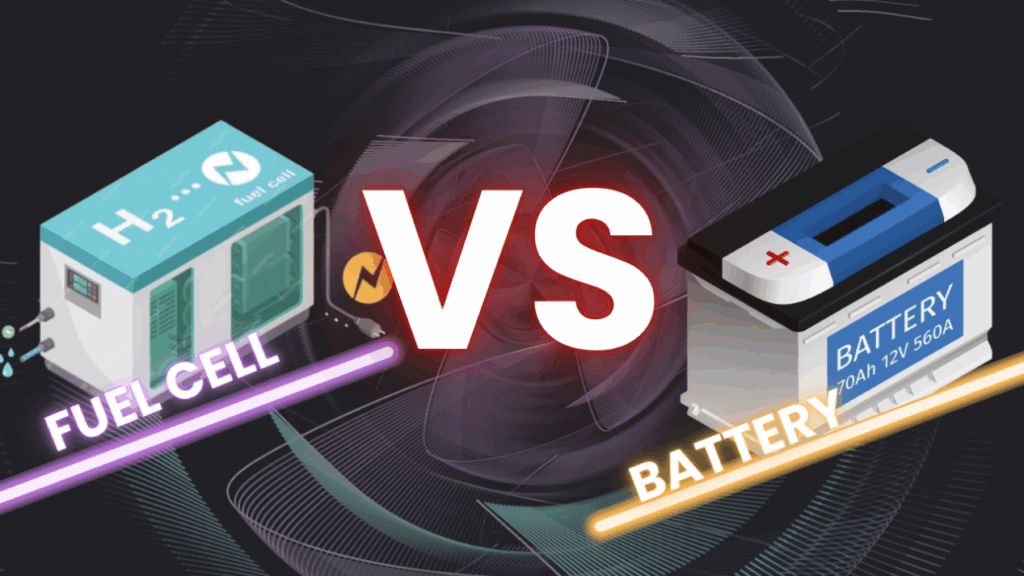Fuel Cell vs Battery: What’s Different? [Ultimate Guide]
Choosing the right technology for clean energy applications demands understanding two key players: batteries and fuel cells. Both power electric vehicles and store renewable energy, but their core functions diverge sharply. One technology stores electrical energy internally for later use, while the other generates electricity continuously through a chemical reaction.
Are they rivals, or complementary solutions? Let’s explore the key contrasts and practical uses that matter most.

Energy Generation vs Energy Storage
The most critical distinction between fuel cells and batteries lies in their core function: how they handle energy.
Fuel Cells: On-Demand Power Generation: A fuel cell doesn’t store pre-made electricity. Instead, it generates electricity continuously through an electrochemical reaction. Typically, this involves feeding hydrogen fuel and oxygen into the cell. As long as these reactants are supplied, the reaction proceeds.
Batteries: Stored Power Reservoirs: A battery operates very differently. It stores electrical energy chemically within its internal materials during charging. When stored chemical energy is depleted, it must be recharged.
Implications for Real-World Use:
Fuel Cells: Their ability to produce electricity continuously as long as fuel is supplied makes them particularly suited for applications demanding long range and quick refueling, such as long-haul transport (trucks, trains, ships) or applications needing constant, extended power without lengthy downtimes (e.g., backup power, some industrial uses).
Batteries: Their self-contained nature, storing energy for later release, excels in applications where convenient charging is readily available and weight/volume efficiency is paramount. This includes consumer electronics (phones, laptops), urban electric vehicles, and grid energy storage where charging cycles can be managed.
Refueling vs Recharging: Which is More Convenient?
The experience of “filling up” highlights another key difference shaped by their core functions.
Fuel Cells: Fast Refueling, Limited Infrastructure: Refueling a hydrogen fuel cell typically takes minutes, similar to gasoline, offering significant time savings. However, this requires specialized infrastructure (hydrogen stations), which remains scarce and expensive compared to electrical grids.
Batteries: Slower Charging, Ubiquitous Access: Recharging batteries takes significantly longer, ranging from hours to potentially less than an hour with fast chargers. The major advantage is widespread access to electrical outlets and an increasingly dense network of EV charging stations.
Impact on Uptime & Mobility:
EVs: Fuel cells offer faster turnaround for long trips, ideal for fleets or long-haul routes. Batteries benefit from home charging convenience and growing public networks for daily commutes.
Drones/Portable Tech: Batteries dominate due to the ease of recharging anywhere. Fuel cells offer longer flight times but face challenges with hydrogen storage/cost and refueling logistics.
Grid Backup: Batteries provide instantaneous power but have a limited duration per charge. Fuel cells can offer extended runtime with fuel supply but depend on reliable hydrogen delivery.

Efficiency, Sustainability, and Lifecycle
Evaluating batteries and fuel cells requires looking beyond immediate operation to efficiency, environmental impact, and longevity.
Efficiency
Batteries generally achieve higher round-trip efficiency (energy retained after charging/discharging) for stationary storage applications.
Fuel cells can demonstrate higher system efficiency in specific mobile applications or situations requiring continuous power generation over long periods, potentially offsetting energy conversion losses.
Environmental Impact
Battery production involves resource extraction (e.g., lithium, cobalt), raising concerns about mining impacts.
Fuel cell sustainability depends critically on hydrogen production methods. “Green” hydrogen (from renewable electricity) offers low emissions, while hydrogen from fossil fuels carries a significant carbon footprint.
Lifespan & Recyclability
Batteries face degradation over charge cycles, reducing capacity over time. Large-scale battery recycling infrastructure is rapidly developing but remains a key challenge.
Fuel cells have fewer moving parts and can have long lifespans, but catalyst degradation (like platinum) occurs. Recycling pathways for fuel cell components are less established than for batteries.
Both technologies present distinct environmental trade-offs demanding careful consideration across their entire lifecycle.

Discover the Future at Mobility Tech Asia 2025
Ready to dive deeper into the future of clean energy? Don’t miss Mobility Tech Asia 2025, where the Hydrogen Summit will spotlight the latest in hydrogen fuel cell technology—from mobility breakthroughs to infrastructure innovation. It’s your chance to connect with top industry leaders and explore real-world applications of fuel cells in transport and beyond.
Plus, with The Battery Show Asia 2025 held alongside, you’ll gain a comprehensive look at both hydrogen and battery-powered solutions under one roof. Register now to join the conversation shaping the next generation of energy!

